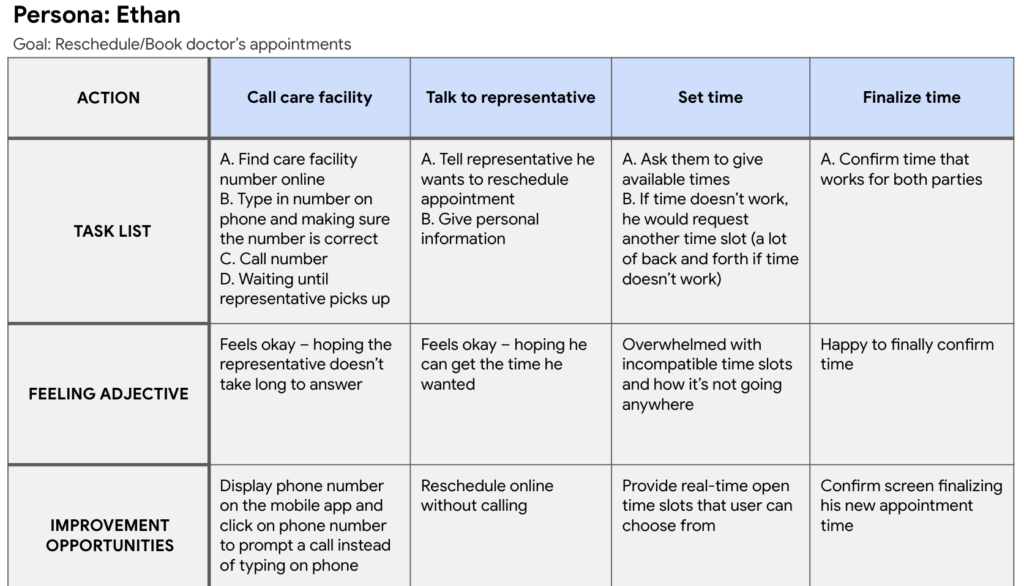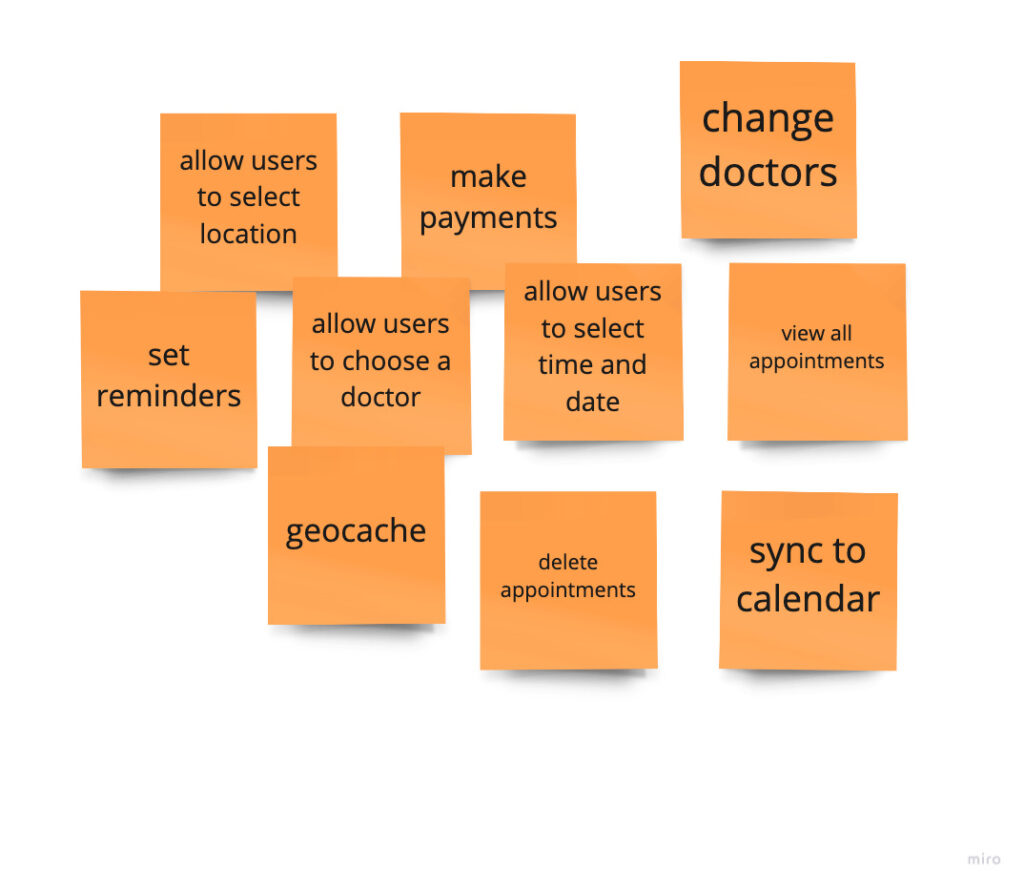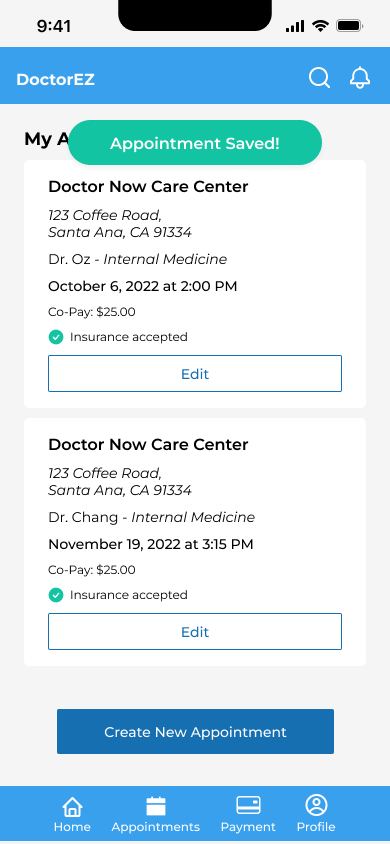Doctor EZ Scheduler
Too long; didn't read (tl;dr)
DoctorEZ Scheduler is an fictional application where patients would like a quick way to schedule/reschedule their appointments. The problem is when patients need to constantly call the doctor's office every time they wanted to adjust their appointments and then wait on the phone trying to find a time/day that fits both parties. This increases the patient's time of looking up the phone number, calling, being on hold, and going back and forth on an appointment time. The goal was to decrease patient's time by creating an online application that allows them to schedule/reschedule their appointment with ease.
“Helping patients schedule/re-schedule their appointments, which our app will solve the problem of patients needing to always call the doctor’s office.”
→ Company: This is a fictional company to complete my Google UX course. DoctorEZ Scheduler is a startup where patients can book their doctor’s office for appointments. Currently, the company is only rolling out for one doctor’s care center as a testing trial.
→ Role: UX/UI Designer
→ Communications with: Friends as “patients/users”
→ Tools: Pen & paper, Miro, Figma
→ Product overview: DoctorEZ Scheduler is a concept app dedicated to helping patients schedule/reschedule their appointments easily without the need to call the doctor’s office.
→ Problem overview: Busy patients disliked calling the doctor’s office to reschedule/schedule their appointment and then trying to find a time that fits both their schedules.
→ Goal: In order to reduce busy patients’ time of needing to call the doctor’s office to adjust an appointment, our app will solve the patient’s problem of scheduling/re-scheduling their appointments online at their convenience.

kickoff.
Please note: This is a fictional company to complete my Google UX Course.
Our company saw an inefficient way of having patients call in all the time to schedule or reschedule their appointments. Our patients have also frequently asked if there was a way to schedule their appointments online. After multiple requests, we decided to find an application where our patients can easily schedule/reschedule their appointments online.
research.
We needed to determine the problem from our patients, so I interviewed them. Some of my questions to the patients were:
→ Tell me about a time when you were frustrated when rescheduling/scheduling an appointment
→ When do you usually reschedule/schedule your appointment during your day-to-day?
→ How often do you forget to reschedule/schedule your appointment?
→ Why do you prefer rescheduling/scheduling an appointment online?
→ How often do you get the actual time/day you wanted when calling to schedule/reschedule your appointment?
→ What happens when you and the assistant can’t find a time/day that works for both parties?
insights.
I try to keep the questions open-ended so I can discover any pain points. Some of the main things I gathered from my interviews were:
→ The patients like to reschedule/schedule their appointments online because they hate calling the office. It is faster for them to quickly see the calendar in person and schedule based on their time/day instead of waiting for the office to say the available time/days. Sometimes it’s frustrating when both parties have conflict and they stay on the phone for a while trying to find a schedule that fits both parties.
→ Sometimes the patients get frustrated if they call the office and no one picks up. They then have to remember to call the office again before they forget.
→ Patients get frustrated when they have to wait on the line because they’re on hold and not knowing how long they’ll need to wait.


I then created user stories based on the personas:
As a busy employee who sees my doctor frequently, I want to book or reschedule my appointment ahead of time, so that I can effectively manage my schedule online instead of calling and waiting.
Before moving further, I wanted to see what the competition offers, so I created a competitive audit:

define.
After researching interviews, I created their current user journey to discover any pain points and gaps within their flow that could be improved.

To focus on the problem statement:
Ethan is a patient who often sees his doctor and would like an way to easily schedule/reschedule his doctor’s appointment because he dislikes calling the office every time he needs to adjust his appointment.
Our doctor’s app will allow users to schedule/reschedule their appointments which will affect busy patients. We will measure effectiveness by how many times patients have scheduled/rescheduled appointments compared to calling the office to adjust their appointments.
ideate.
Now it’s time to turn the main problem of “Our doctor’s app will allow users to schedule/reschedule their appointments which will affect busy patients. We will measure effectiveness by how many times patients have scheduled/rescheduled appointments compared to calling the office to adjust their appointments.” into a solution. But how do we do that? How might we create a scheduling app that will help patients? How might we help reduce patients’ time from calling the office every time they need to reschedule/schedule an appointment?

design.
Onwards to wireframing! I started designing lo-fi wireframes and prototyping. Our initial wireframes started off with being able to view their active appointments and then being able to reschedule an active appointment or schedule a new appointment. I set the user testing on this simple flow of the goal of rescheduling an active appointment.




test.
I received feedback regarding the lo-fi user testing and noted the following:
→ The patients would like to see the actual weekday (e.g. Monday, Tuesday, etc.) instead of only showcasing the days because sometimes they prefer a specific weekday. If they were to only look at the days, they would still look at a calendar to make sure what day that weekday is on.
→ The patients would like to know their current appointment time when rescheduling so they can keep in mind their current appointment time.
→ The word “Cancel” was confusing as to whether they are canceling the appointment, or only canceling the changes made to the appointment.
After the feedback, I made changes to the wires:




key learnings.
Even though this project was fictional, being able to interview friends and get their feedback has helped along the process.